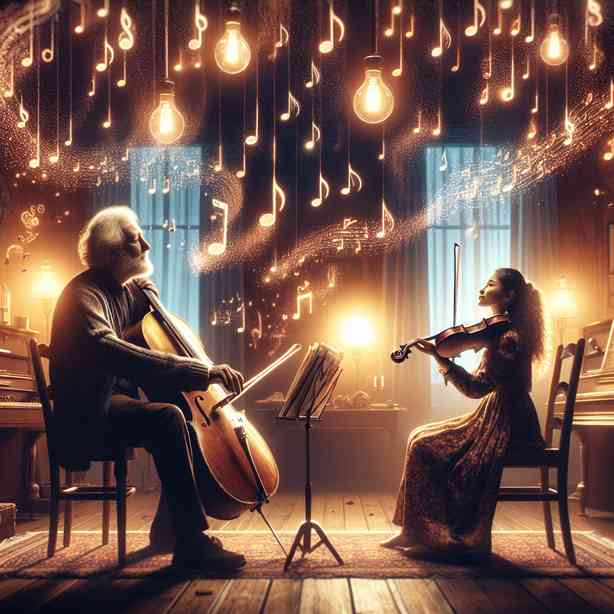
When we think about music, it’s often easy to view it simply as a series of notes and rhythms arranged to create melodies we enjoy. However, music can often feel like a rich, immersive conversation, one that transcends language and connects us deeply with ourselves and others. As we delve into the ways music can mimic a dialogue, explore its emotive power, its social implications, and how it fosters connection, we uncover the profound impact it has on our lives.
To begin with, music has an innate ability to communicate emotions in ways that words sometimes cannot. Take, for example, a powerful symphony or an expressive piece of jazz. Each note, crescendo, and pause tells a story, evoking feelings of joy, sadness, nostalgia, or even anger. Just as in conversation, where tone of voice, pauses, and emphasis play significant roles, music relies on dynamics and phrasing to convey messages. A gentle lullaby soothes like a soft-spoken reassurance, while an upbeat rock song energizes, much like an enthusiastic exchange of ideas. In this way, music becomes a language of its own, creating a space where emotions can be shared and understood without the need for verbalization.
Moreover, the interplay between different musical elements can resemble the back-and-forth of a conversation. For instance, in a duet or a band setting, musicians often respond to each other’s cues, creating a dynamic dialogue that ebbs and flows. This interaction mirrors conversational exchanges, where one person speaks, and the other replies, contributing to an ongoing discussion. When musicians improvise, they tap into a collaborative spirit, much like friends sharing thoughts, and in those spontaneous moments of creation, listeners are invited to witness a unique and vibrant exchange. This collaborative nature enriches the listening experience, making it feel as though the audience is part of the conversation.
In addition to the emotional and interactive aspects, music also has the unique power to bridge cultural gaps. In a world often divided by language and geography, music serves as a universal glue that binds us together. The rhythms of African drums, the melodies of Indian classical music, and the harmonies of Western pop all contain threads of human experience that resonate across societal boundaries. When people dance to the same beat or sing along to familiar melodies, they participate in a collective conversation that fosters unity and belonging. This shared musical experience creates an atmosphere where differences are set aside, and instead, a sense of community emerges.
As we further explore this theme, it’s important to consider how music can facilitate personal conversations with ourselves. Often, when we listen to music, we find ourselves reflecting on our own thoughts and emotions. A poignant ballad may evoke memories of love or loss, prompting an inner dialogue that allows us to process our feelings. In this sense, music becomes a mirror, reflecting our internal struggles and triumphs. This self-conversational aspect of music is particularly evident in genres like singer-songwriter or folk, where the lyrics often delve into personal narratives. Listening to such music can feel like engaging in a heart-to-heart conversation with a trusted friend who understands and empathizes with our experiences.
Furthermore, the power of music as a conversational tool extends into social settings. At gatherings and celebrations, music plays a pivotal role in creating an atmosphere of connection. When people come together to share a song, whether it’s through singing or dancing, a communal dialogue unfolds. This interaction often leads to a shared sense of joy, allowing individuals to bond over a common experience that may be cherished for years to come. The sounds that accompany these moments become woven into the fabric of our memories, reminding us of the importance of connection and conversation in our lives.
In today’s digital age, technology has also transformed how we experience music conversations. Platforms like social media allow artists to engage directly with their audience, inviting listeners into the creative process. Musicians share snippets of new songs, engage in Q&A sessions, and even collaborate with fans. This newfound accessibility reshapes the traditional artist-audience relationship, creating a conversation that is interactive and immediate. Listeners can express their thoughts, share their interpretations, and even influence the music being made. This democratic exchange enriches the musical landscape, making it feel more alive and relevant.
Let’s not forget the role of sound in stimulating intellectual discussions as well. The complexities of musical theory can invite conversations among enthusiasts and scholars alike. From discussing orchestration techniques to the nuances of chord progressions, music often leads to stimulating dialogues that explore its technical facets. These intellectual exchanges enrich our understanding and appreciation of music, allowing listeners to engage with it on multiple levels.
In conclusion, the essence of music as a conversation is deeply rooted in its ability to evoke emotions, foster connections and bridge cultural divides. Whether it’s through the emotional weight of a single note, the dynamic interplay between musicians, or the collective experience of shared joy, music facilitates profound dialogues in various forms. It invites us to connect with ourselves, with others, and even with the world at large. As we continue to explore the depths of music, let us appreciate it not merely as an art form, but as a vital conversation that enriches our lives and brings us closer together. Ultimately, when we engage with music in this way, we find that it truly speaks to the heart of what it means to be human.


